Elden Ring Piece-by-Piece: Dungeons and Dragons
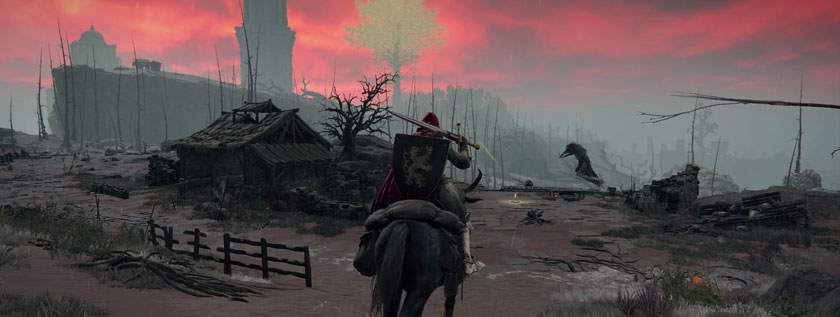
This article is the fourth in a series exploring the game Elden Ring and its design. You can read the prior entry on the adjustments made to combat here.
We’ve now approached the most mixed-of-bags in all of Elden Ring: not just the bosses, but the dungeons that house the majority of them. While there’s enough material to discuss both in isolation, I struggle to separate one from the other. They are where the greatest joy is to be had while also some of the greatest frustration. So many are uniquely designed and crafted and yet they are also incessantly repeated. They are what leave me asking if Elden Ring is, perhaps, too big of a game.
It was impactful to cross over into the rotted land of Caelid and see monstrous and mutated canines scattered across the landscape, overseen by uncomfortably disproportionate crows perched atop the trees. The overwhelming atmosphere indicates to the player that life is unwelcome there, and what creatures exist have been mutated into a grotesque new evolution whose only intent is to annihilate that which does not belong in those rotted plains and lakes. No corner of the land feels as unquestionably hostile as Caelid, and such unique creatures are essential to that identity.
Only you will see them again in later regions, one of which is completely blanketed in snow. Yes, the chill cold of the frozen north, white plains devoid of trees or grass, are often seen as regions hostile to life as well, but there’s also a serene beauty to them. A transcendent peace that contrasts greatly with the shape of a horrific, malformed, oversized dog. While I am certain fans can dig up some lore reason that these creatures prowl such different environments, I would argue that such lore exists solely to give context to recycled content that should have remained unique.
Perhaps, if From Software had allowed Elden Ring to be a bit smaller, they could have crafted more unique foes, dungeons, bosses, and locations. Would it have been an improvement? As all things discussed thus far, it depends on your perspective.
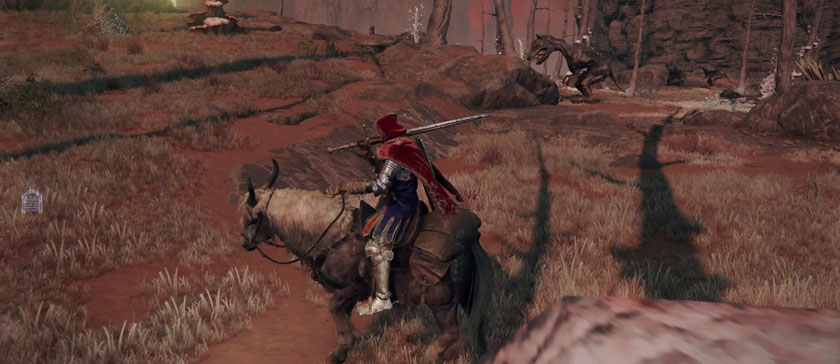
The unnatural looking beast fits right in with the unnatural looking sky, dirt, and flora, so why is it recycled for a completely different ecosystem where it looks out of place?
Before looking at the bosses, however, let’s first consider the dungeons. The mines, catacombs, and caverns which make up the bulk of Elden Ring’s shorter content are in part relied upon to provide the player small, bite-sized chunks of challenge which can be completed “swiftly”. These are separate from the likes of Stormveil Castle, Raya Lucaria Academy, Volcano Manor, or the city of Leyndell, which are akin to entire zones of Dark Souls or Bloodborne. Whereas each of those territories is more uniquely crafted and take a far longer time to explore and complete, these smaller dungeons scattered across the world can take as little as twenty or thirty minutes.
It did not take dozens of hours of play to realize how much recycled content was used in these dungeons, however. Not just the art assets, which can be more easily brushed off. I mean whole rooms are copied and pasted from one to the next, modularly piecing together a dungeon as if disconnecting and reconnecting LEGO bricks together. Those little tiny side passages you see when going down the very first elevator in a mine you discover? Well, there is only one elevator shaft made for such locations, and therefore every elevator encountered has those very same side passages. The only question is whether they’ve been populated with some kind of treasure or not.
The only dungeon type that perhaps conceals its reuse of such chambers are the caverns. It helps that they tend to be rather dark, the lack of illumination doing a better job to conceal recycled assets compared to other locations. Even so, they seem to be where the developers will do the most experimentation, flooding some with pools of poison on the ground or littering them with bushes so that the player may sneak past its denizens. This results in some of the best and worst dungeons in the entire game, such as one filled with spirit-summoning snails and their thralls patrolling through tall grass and bush. Cautious, stealthy play is rewarded for players that sneak through and carefully eliminate the snails, simultaneously wiping out all of the beasts or warriors they called into the world.
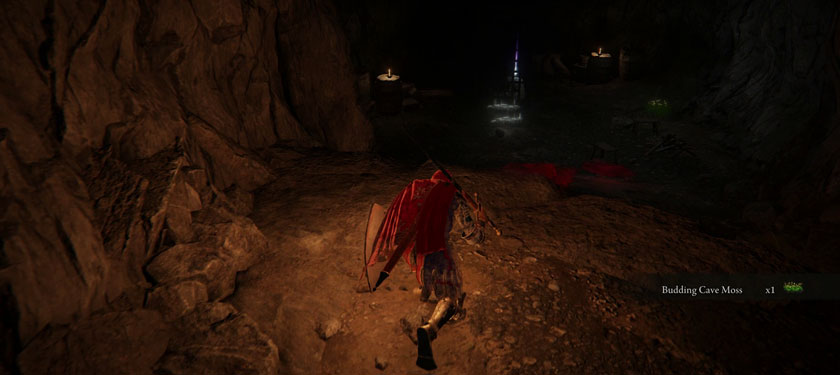
Catacombs, on the other hand, are where the recycled assets stand out the most. I was almost immediately reminded of the Chalice Dungeons, a similar modularly constructed set of labyrinths in Bloodborne. Whereas those were constructed with a procedural element and therefore felt far more repetitive, they were still recycling entire rooms and chambers over and over again with the hope that differently placed enemies and traps would help entertain the player for a longer period of time. The end result was that players found the Chalice Dungeons to be one of the least interesting parts of Bloodborne, though also “necessary” for true, proper full completion of the game due to the presence of a hidden, lore important boss within its depths.
Catacombs are not much different, filled with traps and different foes to distract the player from how copy-paste their locations are. They are far more successful than the Chalice Dungeons in that they were made with a more purposeful hand behind their stitched together parts. One dungeon is littered with illusory walls that must be uncovered and navigated in order to complete it. Another is filled with a series of warp points that must carefully be navigated in order to reach the goal.
In other words, while each catacomb, mine, and cavern is built using not only the same art textures or objects, but entire rooms, chambers, and shafts, there is still an effort to give each one its own unique identity as the game progresses. The earliest ones have the fewest gimmicks due to the player’s lower level and reduced experience with the game’s mechanics, so the recycled art assets will make a far stronger impression to the player early on. Nonetheless, these locations still bear the mark of design with intent. Be it through interesting gimmicks, encounter design, or even platforming challenges from which to retrieve items and treasures, it’s possible to bring up a minor detail and have other players immediately know which dungeon you’re referencing. The spirit snail cavern and warp point catacomb? Chances are, most players know precisely which locations I’m talking about.
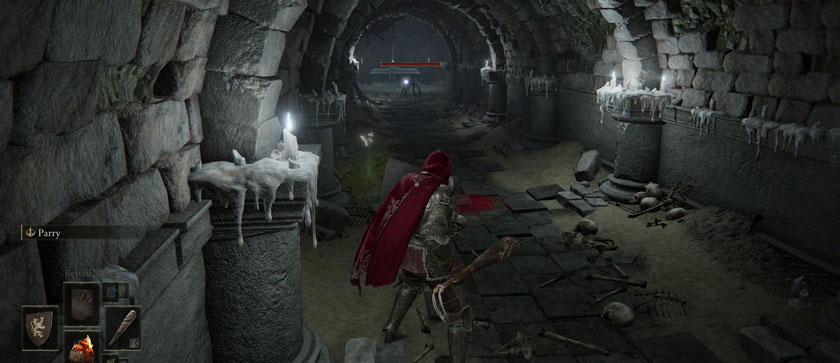
On the other hand, this screenshot could be taken from nearly any catacomb found throughout the game.
This is perhaps also due to From Software’s “show of restraint”. There are a limited amount of each dungeon type per region, with the mines specifically averaging around two for a territory. This has the added benefit of making sure dungeons are plentiful but not overwhelming in number. It’s also a bit of a balancing act as both catacombs and mines are essential locations for select upgrade materials: the gloveworts necessary for strengthening one’s spirit ashes and the smithing stones required for tempering one’s weaponry. I do believe there is a poor balance between the two, as there are far more catacombs than mines whereas far more smithing stones are required for upgrading the rather large selection of weapons found throughout the game compared to the number of spirit ashes (which also only need one glovewort to be upgrade, compared to weapons requiring multiple stones). One could again discuss lore reasons for the more numerous catacombs to exist, but it would and does come at the expense of gameplay.
To try and illustrate my point, I played a Dex-based melee warrior whose magical capabilities were practically nothing. Most of the stones I had come across went into upgrading a handful of weapons. While the game does provide methods of purchasing stones later on, the cost of said stones and limited supply within the world meant that there was a high cost to experimentation with other blades. Though I began to feel as if my build was a poor one by game’s end, a “simple respec” at Raya Lucaria would cost me time in rune farming so that I could purchase the necessary stones and then upgrade the necessary weapons compatible for a new build. If the new specialization didn’t work out, I’d have to repeat the process until landing on something that worked.
Ghost gloveworts, on the other hand, were plentiful and I often upgraded spirit ashes without thinking much about it. The player can unlock the ability to purchase gloveworts as well, but I never had a reason to do so despite cycling between more than a half dozen spirit ashes in my initial run through. Experimenting with spirit ashes is far easier and cheaper than experimenting with weapons or character builds, and yet the dungeons carrying the resource for the former are more common than the latter.

Despite this digression, I want to emphasize that these resources are a part of what make these dungeons so desirable for players to explore. It’s not just “additional content”, nor is it simply a side activity that grants a generic quantity of experience or skill points for completing. They have a specific, tangible resource that is valuable to the player, and despite the recycled assets used, they are arranged and modified in a manner that players will find several dungeons to be memorable. To that end, they also hold the promise of a boss (sometimes two!) toward the end, each granting a unique item that helps expand the player’s arsenal or even progresses a quest line.
Which finally brings us to the numerous monstrous bosses in the game. To first illustrate my point I will begin with an anecdote. When I first played through Elden Ring, I had spelunked into the depths of Stormveil Castle. I had reached an open area that looked all too suspicious, the bones of long dead warriors scattered about. Sure enough, a massive creature emerged, at first resembling some form of skinless serpent. It was an ulcerated tree spirit, and what I mistook for a lack of skin was instead a warped form of bark as flesh. The creature was intimidating and the encounter frightening, but I emerged victorious. It was a shock, but I had defeated the beast and felt as if I had accomplished something.
The next time I saw an ulcerated tree spirit I felt intimidation, but I knew I could take one on. I simply chose to return to it on my time. Then I discovered another, and another, and on they kept appearing until I felt less fear every time. After all, I had figured out the best way to avoid its giant, sweeping attacks and when to tell that it was about to unleash a massive burst of magic around itself.
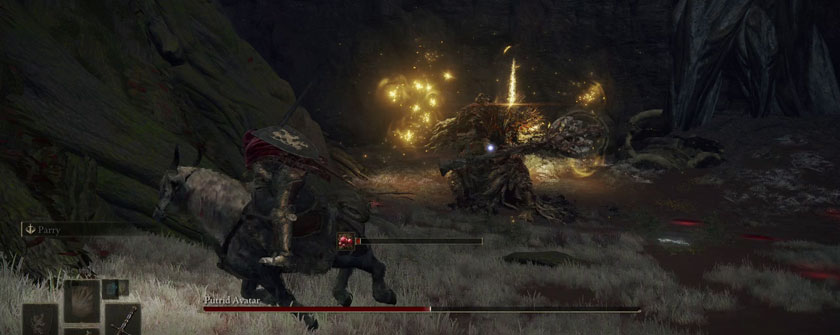
The Putrid Avatar is only different from other Avatars in that it has a rot splashing ground pound attack.
I began to describe a similar process with dragons in the prior entry, where each fight became less and less fearsome. It’s not without effort on From Software’s part, as they will surprise the player with a sudden dragon appearance quite often or leave one stalking in a tricky bit of territory where a single mistake would result in a plummet off of a cliff. The same can be said of the ulcerated tree spirits, as there’s one particular rot infested wood serpent that emerges in an unassuming corner while other hostile sentries wander the area. In such an instance a familiar foe is made all the more intimidating due to the circumstances in which it emerges.
I do not wish to indicate that these separate monsters get boring. They do remain exciting. Yet despite my defense of their copy-paste nature and From Software’s execution, there’s been an objection to it all nagging at the back of my mind.
Even if From Software does a better job with copy-paste assets, are they still not copying and pasting so much, be it in terms of dungeons as well as monsters and bosses, in the simple interest of “more content”? Is “more content” really something video games need?
A lot of players have passed around the famous Photoshop of an Elden Ring screenshot modified to more closely resemble a common, AAA (and Ubisoft specifically) user interface, overloading the player with information and microtransaction advertisements so that they’ll never once have to stop and wonder where they’re going or what they should be doing. I don’t think enough effort goes into understanding what Elden Ring does similarly, though many of the above decisions are a part of what makes the game so different from your average open-world. That a boss seemed to spawn right beneath my feet as I creeped towards a single treasure in an isolated corner was a complete surprise that other developers would never allow to happen. There’d have been a marker on the map indicating a boss fight was there, and I’d have been able to clearly see them so as not to risk an encounter that could kill me. Dungeons and side quests would be clearly marked on a map to discover, and they’d all be some variant of the same objectives. The reward would be something insubstantial like experience points so that players would not have to risk “missing” an important item, skill, or other tangible object with in-game use. Instead, allow the player to simply unlock it in the menu while foes would drop different colored loot as the game progressed, always making sure the player was properly equipped with level-appropriate gear.
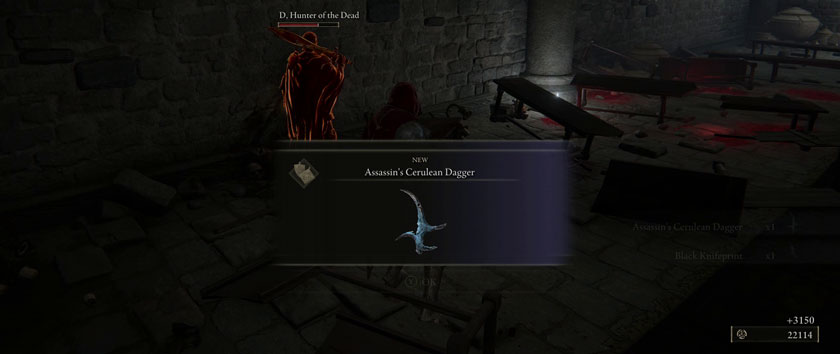
Rewards for defeating one of two bosses within this catacomb.
Instead, players are trusted to want to fight each boss and get a tangible reward, or to dive into each dungeon in order to collect a necessary resource. It doesn’t matter if that reward doesn’t help their particular build any, because at the very least they did receive runes from it all as well as other lesser treasures scattered throughout. The rewards are intrinsic and therefore the player feels a stronger desire to adventure into such dangerous dungeons beyond a sense of completionism or achievement hunting.
At the same time, just because From Software executes on the idea better does not mean they are designing a good open world. Or, at least, designing to the actual potential of what an open world could be. It is still driven by size and quantity of content before anything else, and as a result the player is subjected to a repeat of bosses and dungeons in order to pad out that play time. Just because From Software does it better than their competition does not mean that this is the correct or best method of going about it.
Which, admittedly, goes into a larger topic of whether we even have a good open world game, period. Those many months ago I spoke of the dungeons and their recycled assets as just a fact of open world game design. Even Breath of the Wild crafted their shrines to be minimalistic in order to more easily assemble a unique set of puzzles that they could then scatter across the world. It’s easier to build more of a thing when you don’t have to worry about waiting on assets in the content development pipeline. Final Fantasy XV similarly had an awful lot of easy-to-program monster hunts that would lead the player all over the map, many of which were just open regions where a beast won’t spawn without the quest activation.
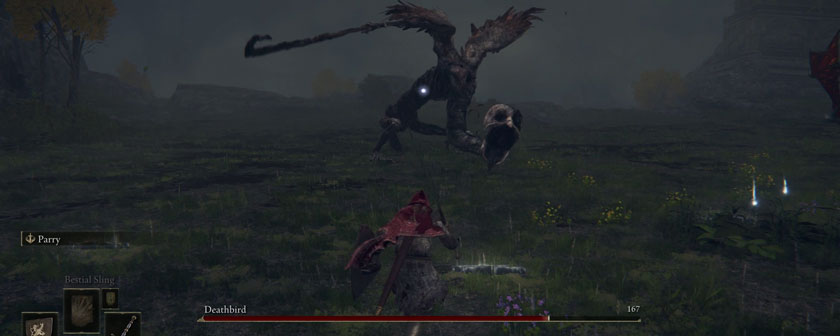
Admittedly, I still haven’t quite gotten a handle on Evil Tweety Bird.
Elden Ring relies on tools that simplify the content creation task just like the games above, but conceals it a bit better through different gimmicks and spreading the content out across a broader variety of recycled assets. In addition, care is taken to modify some of the models to give certain repeat bosses more of an identity, or they’re given somewhat separate attack types, or different dungeons have a stand out gimmick to ensure they are a more memorable experience. There’s a lot done to keep each area from feeling as copy-paste as nearly every other open-world game.
Nonetheless, I cannot help but wonder if more restraint and a smaller world would have allowed them to craft a world that recycled less and allowed for even more unique monsters and territories. This is why I opened today’s piece with the beasts of Caelid: they were unique to that region at one point, but the further in you go the more and more such beasts become recycled for the sake of more content. Just because there’s a reason in the lore for it to happen doesn’t mean it ought to. It’s also hypocritical to forgive From Software for something done by their AAA open world competition that players claim are inferior.
Elden Ring may do a better job at recycling, but it’s recycling nonetheless.
Next time I’ll be discussing the rising difficulty curve towards the end game.


